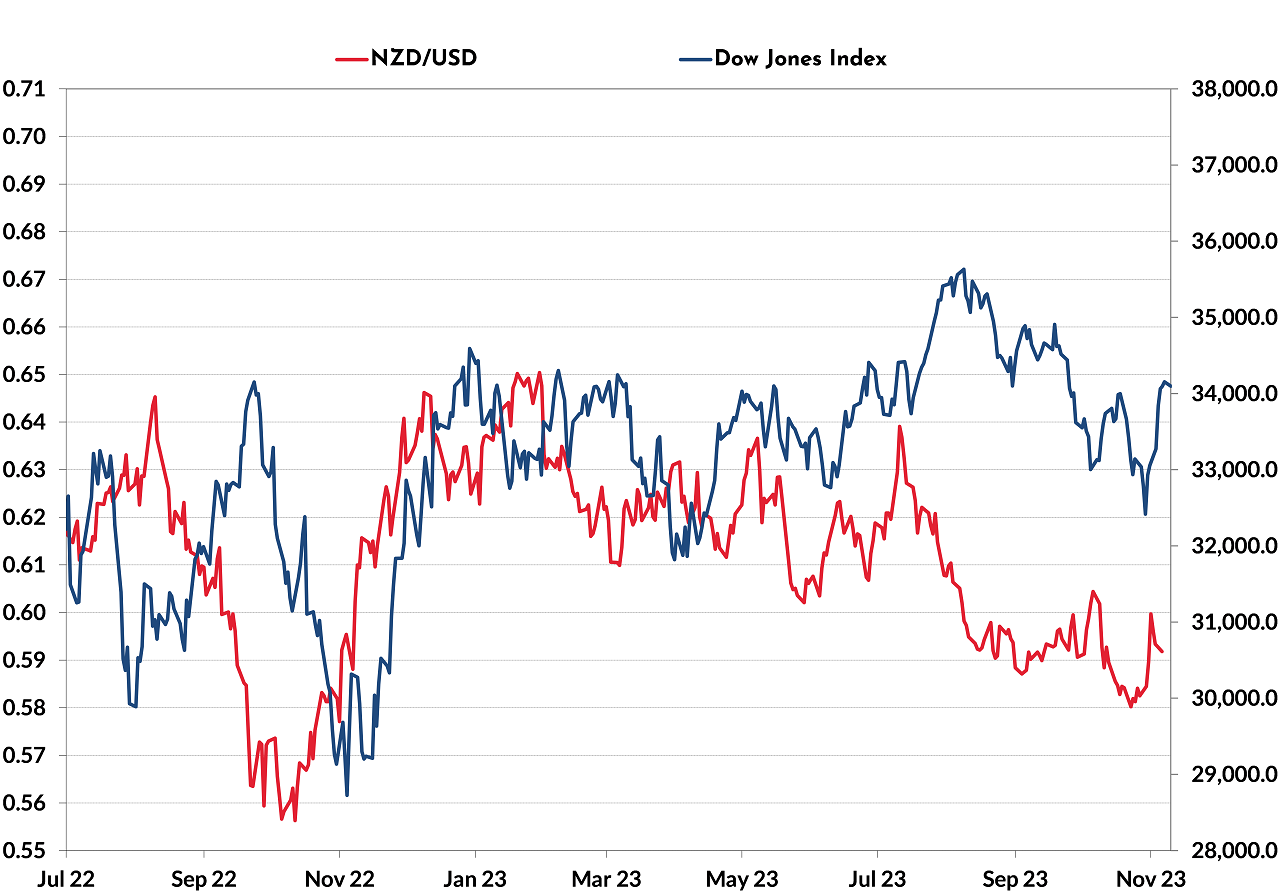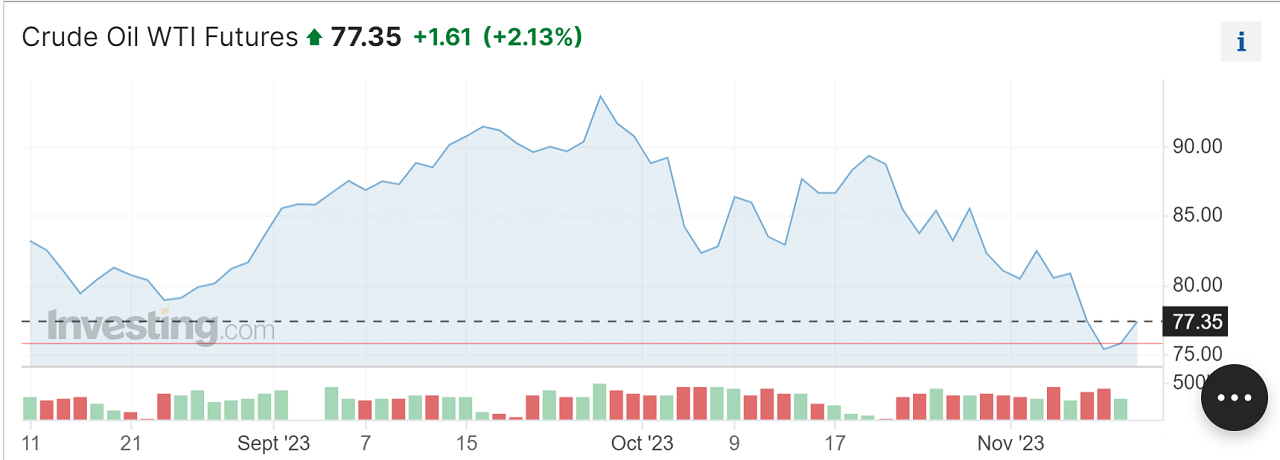
Summary of key points: -
- A return of the “risk-on” investment mode is likely through November and December
- Geo-political risks not playing-out in the markets as most expected
- The US struggles to fund its own deficit and debt
A return of the “risk-on” investment mode is likely through November and December
The continuous switching by global investors between “risk-on” and “risk-off” mode over the course of the last year is reflected in the up-down-up pattern of the US equities Dow Jones Index.
Over recent months the Dow has weakened back from above 35,000 to below 33,000 under the negative weight of rising US bond yields. The “risk-off” mode in investment markets has resulted in the Kiwi dollar and Aussie dollar being under downward pressure since July. The RBNZ selling NZD5 billion over a short time frame in late July causing the divergence between the NZD/USD exchange rate (lower) and US equity markets (higher) at the time (refer chart below). Outside of that bizarre episode, the NZD/USD exchange rate continues to closely track US equity market movements. Through September and October the Kiwi dollar has returned to tracking the Dow both higher and lower. The dramatic pullback lower in US bond yields last week has allowed a resurgence in US equity markets to above 34,000 again. The immediate outlook for the markets appears to be that the “risk-on” investment mode is returning as equities continue to make gains and that bodes well for the NZD/USD rate climbing from 0.5900 back to 0.6000 and staying there.
The US equity market traditionally does better in the months of November and December than October, and this year looks no different, with the threat of further Fed monetary tightening significantly reducing and bond yields more likely to decrease further. Whilst it was bond supply indigestion that caused the 10-year Treasury Bond yields to increase to 5.00%, it is that demand/supply equation now righting itself with a lower volume of longer dated bonds being issued by the US Government that is allowing the yields to reverse back down. Adding to the downward pressure on bond yields from here will be continuing lower US inflation results. Next Tuesday 14th November (Wednesday morning NZT) the US inflation numbers for the month of October are released. The headline increase for the month is forecast to be a low 0.10%, reducing the annual headline rate from 3.70% to 3.30%. The recent rapid decline in crude oil prices back to US$77/barrel (WTI) will be further reducing gasoline, freight and shipping costs through November and December. The expectation has to be that the US headline annual inflation rate will be in the 2.00% to 3.00% region by year-end and therefore rapidly approaching the Fed’s 2.00% target. The Fed Governor, Jerome Powell and his fellow Fed members continue the line that whether interest rates still need to be increased again is always dependent on the emerging economic data. The recent US employment and inflation data has been soft and judging by all the forward looking indicators they will continue to be soft over coming months. The equity markets will reflect that situation by continuing to lift over coming weeks and that augers well for the NZD and AUD.
There was further confirmation of the recent deterioration in US consumer confidence last Friday with the University of Michigan preliminary consumer sentiment index decreasing (again) to 60.4 from 63.8 in October. Tight monetary conditions are now certainly biting hard in the US economy. The end result is lower bond yields, lower USD value, higher equities and appreciating “risk-on” currencies.

Geo-political risks not playing-out in the markets as most expected
The initial and confident prediction by global investment banks to the outbreak of the Hamas/Israel war in Gaza a month ago was that oil prices would surge to over US$100/barrel. Conventional wisdom of the markets is that oil prices always rise when tensions increase in the Middle East. Unfortunately, for those in investment bank punters, the oil price has done exactly the opposite in recent weeks with increased US oil reserves and lower global demand sending oil prices sharply lower. The initial lift in oil prices to US$95/barrel failed to trigger any follow-through buying and very quickly the speculators were reversing their positions, adding to the downward momentum.

Outside of the Middle East war and the Russian/Ukraine war, the other major geo-political risk the financial markets sometimes fret about is the often frosty relationship between the US and China. Trade and investment tensions between these two super powers has increased since the Covid years and at times this does drive safe-haven fund flows into the US dollar. Next week’s APEC summit meeting in San Francisco is setting up to see a de-escalation in those US/China relationship tensions with Premier Xi Jinping meeting with President Joe Biden. The US dollar has strengthened in the past when the trade and investment relationship between China and the US has soured, an improvement in the relationship at the summit meeting would be marginally negative for the USD as earlier safe-haven flows into the USD are reversed out. Whether the Chinese economy has stabilised enough to attract back in US investment funds to Chinese equity markets remains to be seen. At least the stabilisation of the Chinese economy and Yuan exchange rate at 7.3100 has removed some of the currency risk of investing in China.
What is starting to return to favour is global funds buying back into emerging market economies in Asia (Philippines, Taiwan, Thailand, Indonesia etc). The investment managers are taking the view that these emerging market equity markets and home currency values are at nice low entry points as they suffered falls from rising US interest rates and USD value over recent years. The NZD and AUD have a loose correlation to emerging market equity markets and currency trends and would likely appreciate on the back of stronger fund inflows into these markets/currencies.
The US struggles to fund its own deficit and debt
Financial and investment markets from around the world will again be focussed on the US Government Congress over the next week in the run-up to the 18th of November deadline date for Government funding closure unless the House of Representatives vote another extension. It cannot be positive for the US economy or currency value if the US Government is unable to pay its own bills. The new Republican Speaker of the House does not instil much confidence has can unify the rabble in his own political party and pass an orderly funding vote.
Further eroding confidence in the US Government when it comes to finances, is the glaring fact that the US nation does not have sufficient domestic savings to fund its own enormous budget deficits. The deficits are increasing under the weight of the now massive annual interest bills the US Government is paying with the increased debt, which is all at much higher interest rates then recent years. It is a risky, self-fulfilling spiral that they are now having to contend with. The US has always relied on foreign investors buying up to 30% of the Government Treasury bonds that are issued. The dramatic increase in 10-year Treasury Bond yields to 5.00% recently is a confirmation that the foreign investors are absent from the market. Foreign investors do not like the high value of the USD currency value as an entry point and are just not buying the bonds. A further set back for the US Government last week was credit-rating agency, Moody’s changing the outlook on the Government’s AAA rating from “stable” to “negative”. Standard & Poor’s and Fitch had already sifted to a negative outlook.
Over history, the US dollar has always depreciated in value over periods when the US Government runs a fiscal deficit greater than 5% of GDP. At some point, the status and reputation of the US dollar as the one and only favoured reserve currency will be dented by their own deteriorating economic fundamentals.
Daily exchange rates
Select chart tabs
*Roger J Kerr is Executive Chairman of Barrington Treasury Services NZ Limited. He has written commentaries on the NZ dollar since 1981.
4 Comments
Bondholders don't finance the US governments spending as it must spend its currency first before bonds can be issued. Americas problem is its current account deficits and not its government deficits. Foreign entities receive their US Dollars through trade and they then invest these in bonds and not because the government is running budget deficits. All domestic and international interbank payments in US Dollars are made by using US Dollar Currency Reserves issued by the US Government and held in its central bank.




We welcome your comments below. If you are not already registered, please register to comment.
Remember we welcome robust, respectful and insightful debate. We don't welcome abusive or defamatory comments and will de-register those repeatedly making such comments. Our current comment policy is here.